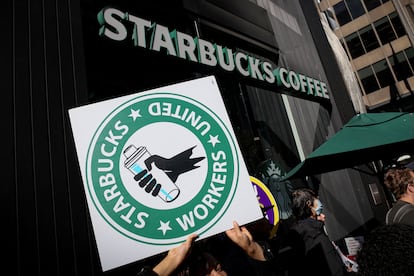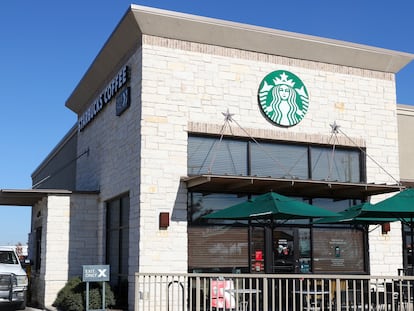Taking it to the board: How workers got Starbucks to the negotiating table
The new wave in U.S. unionism is using investment funds to take their protests all the way to shareholder meetings

At Starbucks board meetings, there are always two empty chairs. One represents the employees and the other the customers. It was the idea of Howard Schultz, the company’s CEO on several occasions, who transformed Starbucks into the largest coffeehouse chain in the world. He claimed that it was a reminder that decisions should be made with the employees, not the shareholders, in mind. But the coffee company’s workers have gotten tired of the metaphor: they have decided that the eternally empty armchair should no longer be empty and chose to become shareholders. The future of work also involves new formulas for union struggle.
In December 2021, the first Starbucks union was formed in Buffalo, New York. Since then, nearly 10,000 workers in more than 400 of the 9,000 coffee shops in the United States have chosen Starbucks Workers United (SWU) as their representative. But it was not until February 2024 that the company agreed to begin collective bargaining with the union. After over two years of protests, it was a shareholder activist maneuver that made this possible.
“The activist shareholder is the person who publicly says that he does not agree with certain company practices and conducts a campaign to push [it] in another direction,” explains Borja Miranda, the director of mergers, acquisitions and activism at Morrow Sodali, a firm specializing in studying company shareholders. “They are shareholders who don’t have enough power and are looking to add support to achieve a critical mass capable of approving what they are asking for,” he notes. That was the workers’ objective when they used their shares to propose three names to occupy a seat on the new board of directors, taking advantage of the shareholders’ meeting held on March 13.
The proposal was submitted by the Strategic Organizing Center (SOC), a small section within a coalition of unions that includes over 2 million workers. One of its offshoots is an investment fund of the same name, which manages its members’ retirement funds so that they receive better pensions. Converted into shares, that money has allowed them to put pressure on other large companies like Amazon, McDonald’s and Tesla.
The $16,000 in Starbucks stock they own amounts to less than 0.001% of the total, but along with the proposed nominees, they managed to send a message to shareholders. " At a time when Starbucks has set an ambitious goal of opening more than 17,000 new stores by 2030, it cannot waste any more resources fighting its own workers,” they said in a statement.
According to the SOC, Starbucks has spent $240 million in the past year, and its expenses include paying lawyers and the costs of penalties for illegal firings and irregular closing of some stores following a union victory. Andrew Trull, a Starbucks spokesman, denies those allegations: “Our board of directors works to ensure that our [activities] as a company remain aligned with the principles of freedom of association and proper collective bargaining.”
Addressing shareholders
Starbucks has a reputation in the United States for offering higher wages and better health insurance than other companies in the industry. While the coffee chain has been at pains to deny any move that could be described as “anti-union,” the investment fund has accused management of damaging the company’s reputation: “Starbucks is a company in crisis” with a “flawed human capital management strategy,” which has “materially damaged the value of the Company’s brand and negatively impacted its shareholders, partners and customers.”
Among shareholders, these types of arguments are becoming increasingly common. “Small investors are beginning to emerge, who are not activists by nature, but who believe that some company practices need to change,” says Borja Miranda. The expert observes that of the almost 2,000 known activist campaigns worldwide in the last year, the vast majority have been related to governance, environmental policies and social issues. For the director of activism at Morrow Sodali, most of the time the objective is to “safeguard the value chain of companies” and preserve their prestige.
Taking advantage of a shareholders’ meeting to pressure the company is just another strategy in the resurgent union movement in the United States. Since 2021, the number of strikes has doubled and the number of workers involved has nearly quadrupled, according to the ILR School. That same year, the first unions were created at Starbucks thanks to a strategy called “salting,” a practice revived from the early 20th century that consists of infiltrating a company with the sole objective of creating a union organization. Arjae Rebbmann was one of those who infiltrated Starbucks.
“It was fairly easy to get the job,” Rebbmann recalls. “Fast food companies have a lot of staff turnover and don’t care who they hire.” He tells EL PAÍS that throughout the interview he kept his arms crossed so that the hammer and sickle tattoo on his left forearm could not be seen. “The difficult thing about salting is that you have to work for months to gain everyone’s trust. At the same time, you [also] have to deal with the company’s anti-union propaganda and the threat of dismissal for workers who organize,” he explains.
This same tactic worked at Amazon, where the company’s first union was formed in April 2022. “They are the line to follow. Starbucks Workers United and the Amazon Labor Union were the first to start acting after 40 years without a union movement,” says Jaime Caro, a specialist in the U.S. labor movement and a contributor to the specialized newspaper El Orden Mundial (The World Order). Inflation, the post-pandemic effects and a political left that is regaining some life, including the SOC, are behind the resurgence of American unionism.
In addition to a collation of unions with an investment fund, the SOC is a school of trade unionists linked to left-wing parties in the United States, such as the Democratic Socialists of America (DSA), associated with well-known figures such as Bernie Sanders and Alexandria Ocasio-Cortez. “Its intention is to train trade unionists capable of carrying out more radical strategies of struggle and organizing, such as demanding large wage increases or salting, strategies that are unthinkable for traditional unions,” says Caro.
In 2023, the UAW, the automobile industry union called one of the largest strikes in U.S. history led by Shawn Fein. Fein has been called a radical for his leftist positions and his firmness in negotiations. The work stoppages at Stellantis, Ford and General Motors ended in a 25% wage improvement. “That has had a contagion effect that has [influenced] much less combative unions, such as the casino workers in Chicago and Atlanta, and the service workers in Las Vegas, who have [secured] a 25% raise, with only the threat of a strike,” notes the labor movement specialist.
The three Starbucks candidates’ proposal to the shareholders’ meeting represents another step in the union strategy. Miranda believes that this may make “companies pay more attention to social aspects and [push] regulators [to] encourage companies to move in this direction. It’s a warning… a call for them to be aware of new trends,” he says.
Starbucks union victory
On February 27, Starbucks released a statement: “Starbucks and Workers United have agreed to begin discussions on a foundational framework designed to achieve both collective bargaining agreements for represented stores and partners, and the resolution of litigation between the union and the company. This includes resolving litigation related to both the partner benefits announced in May 2022, and the use of the Starbucks brand.”
A giant step forward made possible by thousands and thousands of us joining together and speaking out…
— Starbucks Workers United (@SBWorkersUnited) February 27, 2024
🚨THIS IS HUGE.🚨 pic.twitter.com/zZZ57Am0Bm
Having won this victory, a week before the shareholder meeting, on March 5, a the SOC investment fund announced its withdrawal: “We feel that now is the time to acknowledge the progress that has been made and to allow the Company and its workers to focus on moving forward. As such, we are withdrawing our director nominations.” In the same statement, they asked the remaining shareholders to continue to “monitor the Board’s performance and Starbucks’ approach to labor relations issues.”
“When we said we were going to organize at Starbucks, we were called crazy, but we did it, and we won,” Rebbmann now states proudly. The new union movements in the U.S. are pushing on several fronts, the 25% wage hike has become a benchmark for many labor disputes and, according to a Gallup poll, support for unions is at 67%, a figure not seen for over 60 years. The seat on the new Starbucks board will remain empty for now, but workers will be more present than ever.
Sign up for our weekly newsletter to get more English-language news coverage from EL PAÍS USA Edition
Tu suscripción se está usando en otro dispositivo
¿Quieres añadir otro usuario a tu suscripción?
Si continúas leyendo en este dispositivo, no se podrá leer en el otro.
FlechaTu suscripción se está usando en otro dispositivo y solo puedes acceder a EL PAÍS desde un dispositivo a la vez.
Si quieres compartir tu cuenta, cambia tu suscripción a la modalidad Premium, así podrás añadir otro usuario. Cada uno accederá con su propia cuenta de email, lo que os permitirá personalizar vuestra experiencia en EL PAÍS.
¿Tienes una suscripción de empresa? Accede aquí para contratar más cuentas.
En el caso de no saber quién está usando tu cuenta, te recomendamos cambiar tu contraseña aquí.
Si decides continuar compartiendo tu cuenta, este mensaje se mostrará en tu dispositivo y en el de la otra persona que está usando tu cuenta de forma indefinida, afectando a tu experiencia de lectura. Puedes consultar aquí los términos y condiciones de la suscripción digital.
More information
Archived In
Últimas noticias
Chris Martin, Taylor Swift, Elijah Wood and other famous wedding ‘crashers’
‘How does it feel to be a failure?’: Elizabeth Berkley’s journey from ‘Showgirls’ ridicule to vindication
The story of the Málaga virus: The code that haunted Google’s cybersecurity center director for 30 years
The impact of Ecuador’s mega-prison: A polluted river, cleared forests and military checkpoints
Most viewed
- Christian Louboutin: ‘Young people don’t want to be like their parents. And if their parents wear sneakers, they’re going to look for something else’
- The low-cost creative revolution: How technology is making art accessible to everyone
- Liset Menéndez de la Prida, neuroscientist: ‘It’s not normal to constantly seek pleasure; it’s important to be bored, to be calm’
- All the effects of gentrification in one corner of Mexico’s Colonia Roma
- December Social Security and SSI payments: Dates, double checks and the 2026 COLA increase










































